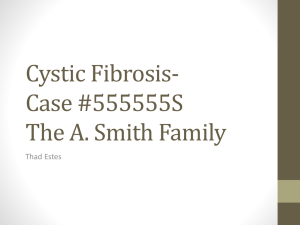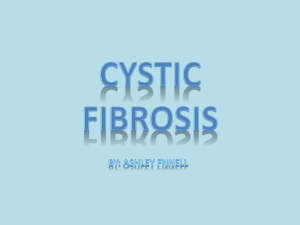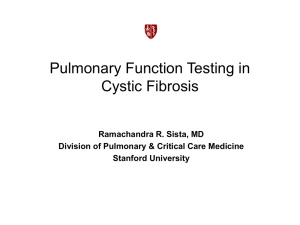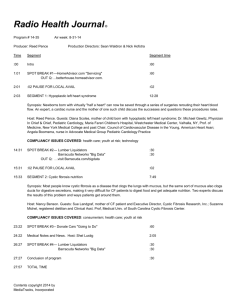Document 11270173
advertisement
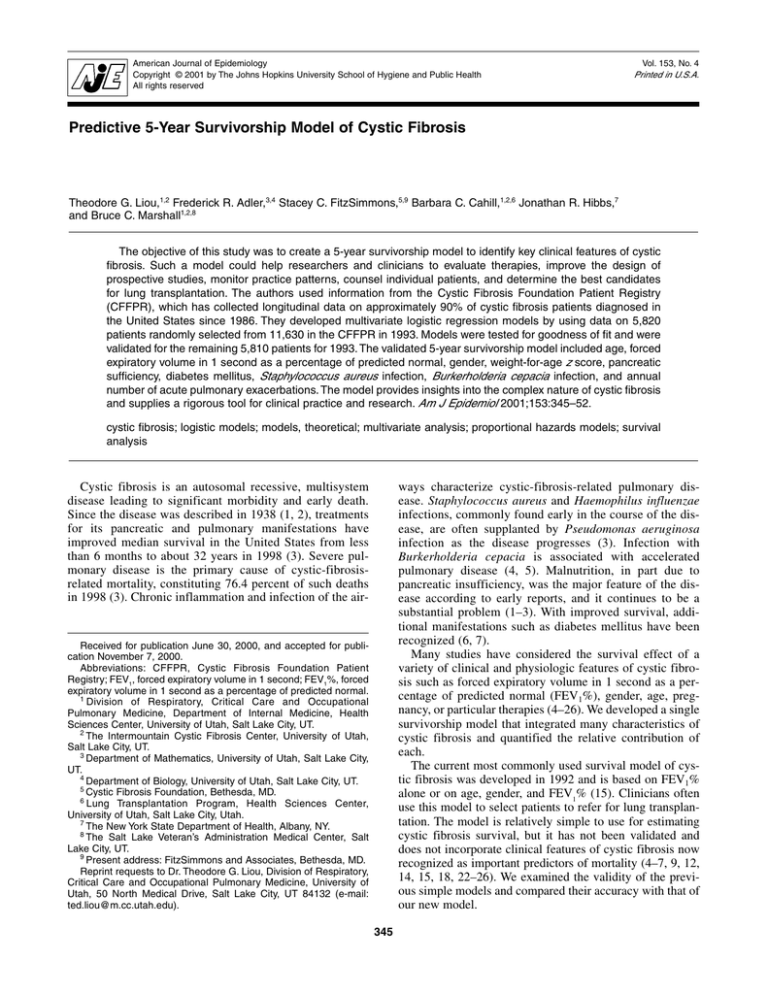
American Journal of Epidemiology Copyright © 2001 by The Johns Hopkins University School of Hygiene and Public Health All rights reserved Vol. 153, No. 4 Printed in U.S.A. Five-Year Survivorship Model of Cystic Fibrosis Liou et al. Predictive 5-Year Survivorship Model of Cystic Fibrosis Theodore G. Liou,1,2 Frederick R. Adler,3,4 Stacey C. FitzSimmons,5,9 Barbara C. Cahill,1,2,6 Jonathan R. Hibbs,7 and Bruce C. Marshall1,2,8 The objective of this study was to create a 5-year survivorship model to identify key clinical features of cystic fibrosis. Such a model could help researchers and clinicians to evaluate therapies, improve the design of prospective studies, monitor practice patterns, counsel individual patients, and determine the best candidates for lung transplantation. The authors used information from the Cystic Fibrosis Foundation Patient Registry (CFFPR), which has collected longitudinal data on approximately 90% of cystic fibrosis patients diagnosed in the United States since 1986. They developed multivariate logistic regression models by using data on 5,820 patients randomly selected from 11,630 in the CFFPR in 1993. Models were tested for goodness of fit and were validated for the remaining 5,810 patients for 1993. The validated 5-year survivorship model included age, forced expiratory volume in 1 second as a percentage of predicted normal, gender, weight-for-age z score, pancreatic sufficiency, diabetes mellitus, Staphylococcus aureus infection, Burkerholderia cepacia infection, and annual number of acute pulmonary exacerbations. The model provides insights into the complex nature of cystic fibrosis and supplies a rigorous tool for clinical practice and research. Am J Epidemiol 2001;153:345–52. cystic fibrosis; logistic models; models, theoretical; multivariate analysis; proportional hazards models; survival analysis ways characterize cystic-fibrosis-related pulmonary disease. Staphylococcus aureus and Haemophilus influenzae infections, commonly found early in the course of the disease, are often supplanted by Pseudomonas aeruginosa infection as the disease progresses (3). Infection with Burkerholderia cepacia is associated with accelerated pulmonary disease (4, 5). Malnutrition, in part due to pancreatic insufficiency, was the major feature of the disease according to early reports, and it continues to be a substantial problem (1–3). With improved survival, additional manifestations such as diabetes mellitus have been recognized (6, 7). Many studies have considered the survival effect of a variety of clinical and physiologic features of cystic fibrosis such as forced expiratory volume in 1 second as a percentage of predicted normal (FEV1%), gender, age, pregnancy, or particular therapies (4–26). We developed a single survivorship model that integrated many characteristics of cystic fibrosis and quantified the relative contribution of each. The current most commonly used survival model of cystic fibrosis was developed in 1992 and is based on FEV1% alone or on age, gender, and FEV1% (15). Clinicians often use this model to select patients to refer for lung transplantation. The model is relatively simple to use for estimating cystic fibrosis survival, but it has not been validated and does not incorporate clinical features of cystic fibrosis now recognized as important predictors of mortality (4–7, 9, 12, 14, 15, 18, 22–26). We examined the validity of the previous simple models and compared their accuracy with that of our new model. Cystic fibrosis is an autosomal recessive, multisystem disease leading to significant morbidity and early death. Since the disease was described in 1938 (1, 2), treatments for its pancreatic and pulmonary manifestations have improved median survival in the United States from less than 6 months to about 32 years in 1998 (3). Severe pulmonary disease is the primary cause of cystic-fibrosisrelated mortality, constituting 76.4 percent of such deaths in 1998 (3). Chronic inflammation and infection of the air- Received for publication June 30, 2000, and accepted for publication November 7, 2000. Abbreviations: CFFPR, Cystic Fibrosis Foundation Patient Registry; FEV1, forced expiratory volume in 1 second; FEV1%, forced expiratory volume in 1 second as a percentage of predicted normal. 1 Division of Respiratory, Critical Care and Occupational Pulmonary Medicine, Department of Internal Medicine, Health Sciences Center, University of Utah, Salt Lake City, UT. 2 The Intermountain Cystic Fibrosis Center, University of Utah, Salt Lake City, UT. 3 Department of Mathematics, University of Utah, Salt Lake City, UT. 4 Department of Biology, University of Utah, Salt Lake City, UT. 5 Cystic Fibrosis Foundation, Bethesda, MD. 6 Lung Transplantation Program, Health Sciences Center, University of Utah, Salt Lake City, Utah. 7 The New York State Department of Health, Albany, NY. 8 The Salt Lake Veteran’s Administration Medical Center, Salt Lake City, UT. 9 Present address: FitzSimmons and Associates, Bethesda, MD. Reprint requests to Dr. Theodore G. Liou, Division of Respiratory, Critical Care and Occupational Pulmonary Medicine, University of Utah, 50 North Medical Drive, Salt Lake City, UT 84132 (e-mail: ted.liou@m.cc.utah.edu). 345 346 Liou et al. MATERIALS AND METHODS Rate of decline in FEV1% Cystic Fibrosis Foundation Patient Registry data To estimate the slopes of the rates of decline in FEV1%, linear and mixed-effects linear models were generated for each patient who was alive on January 1, 1993, and for whom there was more than one measurement (23). We used all 1986–1992 pulmonary function test data (two to five measurements). We used information from the Cystic Fibrosis Foundation Patient Registry (CFFPR; 1986–1997), which contains longitudinal data on 27,849 patients at 115 cystic fibrosis care centers, representing approximately 90 percent of all cystic fibrosis patients in the United States (3). Reports for each patient, containing a wide range of clinical data, are submitted annually to the CFFPR. CFFPR methods are described elsewhere (27). In accordance with the Cystic Fibrosis Foundation data access policy, we applied for and received access to a 1986–1996 longitudinal database, which was later updated with the complete 1997 database and 1998 mortality data. Patient selection Cystic fibrosis patients who were alive on January 1, 1993, and for whom follow-up data were available through December 31, 1997, were included in our study. Data on patients with odd identification numbers were used to develop survival models; those from patients with even identification numbers were used for the validation set. Patients were excluded from the study if they had undergone solid organ transplantation of any type or lacked pulmonary function testing information, a key clinical parameter of cystic fibrosis. Data handling and statistical modeling tools We used S-PLUS software (version 3.4, release 1 for Sun SPARC, SunOS 5.3: 1996 (Mathsoft, Inc., Cambridge, Massachusetts)) to perform statistical analyses (28). S-PLUS is hosted by the Sun UltraSPARC 2170/2200 cluster (Sun Microsystems, Inc., Palo Alto, California) of the University of Utah Department of Mathematics. Prediction equations for FEV1% and forced vital capacity Raw spirometry values, forced expiratory volume in 1 second (FEV1), and forced vital capacity were normalized to FEV1% and percentage of predicted forced vital capacity. We used regression formulae from the Third National Health and Nutrition Examination Survey (29). Calculation of weight-for-age z scores Weight-for-age z scores were calculated by using National Center for Health Statistics (Hyattsville, Maryland) weight-for-age growth tables for males and females. Gender and age were used to determine the appropriate median weight for age for each patient in the 1993 CFFPR. Because the distribution of weight for age was not normal, the z score was calculated by using the approximation method of Lai et al. and Dibley et al. (13, 30). Statistical models for survival analysis To predict 5-year survivorship for cystic fibrosis patients, we used a binary variable, alive or deceased within a 5-year time period, as the outcome variable. All potential explanatory covariates were incorporated into a logistic regression model. Forward stepwise procedures and log-likelihood ratio tests were used to select variables for the model. Parallel analysis with Cox proportional hazards regression was performed. Selection of variables for survival analysis Data on 317 variables were collected by the CFFPR in 1993. We excluded variables that related directly to ongoing research protocols, for which data were sparse, or that recorded clinically uncommon or rare characteristics (table 1). However, our analysis included infection with B. cepacia (2.8 percent of the population affected) because of prior reports of its effects on mortality (4, 5, 24, 31) and infection with Stenotrophomonas maltophilia (1.7 percent of the population affected) because of its increasing prevalence (3). The pertinent variables, including weight-for-age z scores and FEV1% slopes, were tested by using univariate logistic regression for an effect on 5-year survivorship. Potentially interacting variables were identified by using stratified regression analysis (31). Modeling of 5-year survivorship Variables that demonstrated an association with 5-year survivorship at an absolute t-test value of more than two were considered for multivariate logistic regression analysis. Twenty-one variables were included in the final multivariate analysis. The model was subjected to stepwise analysis of variance to derive an intermediate model (32). By using these variables, along with patient age, we constructed models that included all possible interactions and excluded statistically nonsignificant terms by using stepwise analysis of variance prior to validation. All possible interaction terms were considered, including those identified by stratified analysis, and terms that lacked statistical significance were excluded (31). For comparison, we developed simpler models by using only the covariates identified by Kerem et al. (15). Assessing models for goodness of fit and validation Models developed by using information from oddnumbered patients were validated by using 1993 patients who had even identification numbers. We used the HosmerAm J Epidemiol Vol. 153, No. 4, 2001 Five-Year Survivorship Model of Cystic Fibrosis 347 TABLE 1. Covariates excluded from the survivorship model used to identify key clinical features of cystic fibrosis, Cystic Fibrosis Foundation Patient Registry, United States, 1993 Not statistically significant* Insufficient data† Height (raw value and percentile) Other Pseudomonas ∆F508‡ Mucoid Pseudomonas Pseudomonas aeruginosa Alcaligenes xylosoxidans Stenotrophomonas maltophilia Aspergillus fumigatus Haemophilus influenzae Methillicin-resistant Staphylococcus aureus Pregnancy Birth complications Sweat chloride test value at diagnosis Employment Education Insurance status FEV1%§ slope by linear regression Marital status FEV1% slope by mixed-effects modeling * p > 0.05. † Information on some of these covariates was available from less than 5 percent of the population. If information was available, covariates were excluded if less than 5 percent of the cystic fibrosis population was affected; most of these excluded variables affected fewer than 10 patients. ‡ A specific test of whether the presence of no, one, or two ∆F508 alleles had a survival effect. § FEV1%, forced expiratory volume in 1 second as a percentage of predicted normal. Lemeshow test to eliminate models that fit poorly; the remaining models were compared with standard χ2 likelihood ratio statistics (31). RESULTS The CFFPR contains 1993 data on 19,156 patients. Of these, we excluded 730 patients because they were recipients of solid organ transplantation and 5,686 because they lacked FEV1% measurements. Of these latter patients, 4,190 were excluded because they were younger than age 5.5 years, a group for whom FEV1% cannot be measured using standard techniques, or were members of ethnic or racial groups for whom FEV1% standards do not exist (54 patients). Microbiology, pancreatic sufficiency, diabetes, or acute exacerbation information was missing for 1,056 patients. Of the 12,686 patients remaining after exclusions, we included information on 11,630 (92 percent) of them in developing and validating the model. We developed the survivorship model by using data on 5,820 patients with odd identification numbers, and we validated the model externally by using data on 5,810 patients with even identification numbers. Baseline characteristics of the development and validation patient populations were similar (table 2). There were 1,419 deaths spread evenly between the development and validation groups. Univariate logistic regression analyses identified 21 variables with a significant predictive value for 5-year survivorship. Clinically relevant variables that did not add predictive information to the model were eliminated (table 1). In our investigation of interactions among the remaining variables using stratified analysis, we found five potential interaction terms for multivariate analysis. Am J Epidemiol Vol. 153, No. 4, 2001 TABLE 2. Characteristics of model development and validation patients, Cystic Fibrosis Foundation Patient Registry, United States, 1993 Characteristic No. of patients Patients Development Validation 5,820 5,810 Mean age (years) (SD*) 17.58 (9.25) 17.64 (9.36) Median age (years) (range) 15.52 (5.5–62.44) 15.32 (5.5–71.05) Mean FEV1%* (SD) 67.7 (29.2) 67.4 (29.3) Female gender (%) 2,729 (47) 2,692 (46) –0.85 (1.07) –0.84 (1.05) Pancreatic sufficiency (%) 311 (5.3) 308 (5.3) With diabetes mellitus (%) 357 (6.1) 367 (6.3) With Staphylococcus aureus (%) 1,780 (30.6) 1,802 (31.0) With Burkerholderia cepacia (%) 186 (3.2) 231 (4.0) Mean no. of acute exacerbations (range) 1.1 (0–18) 1.2 (0–19) Mean weight-for-age z score (SD) * SD, standard deviation; FEV1%, forced expiratory volume in 1 second as a percentage of predicted normal. The best multiple logistic regression model included nine variables with one interaction (table 3). Higher FEV1%, higher weight-for-age z score, pancreatic sufficiency, and S. aureus infection predicted increased survivorship. Increasing age, female gender, diabetes mellitus, B. cepacia infection, and a higher number of acute pulmonary exacerbations predicted decreased survivorship. After stepwise analysis, only one of the five potential interaction terms (B. cepacia infection × number of acute pulmonary exacerba- 348 Liou et al. TABLE 3. Validated 5-year logistic regression survivorship model for cystic fibrosis,* Cystic Fibrosis Foundation Patient Registry, United States, 1993 Covariate† (x0–10) (Intercept) Coefficient β0–10 1.93 SE‡ Odds ratio FEV1%‡ equivalence§ 0.27 6.88 50 Age (per year) –0.028 0.0060 0.97 –0.7 Gender (male = 0, female = 1) –0.23 0.10 0.79 –6 FEV1% (per %)¶ 0.038 0.0028 1.04 1 Weight-for-age z score 0.40 0.053 1.50 10 Pancreatic sufficiency (0 or 1)¶ 0.45 0.31 1.58 12 –0.49 0.15 0.61 –13 Staphylococcus aureus (0 or 1)¶ Diabetes mellitus (0 or 1)¶ 0.21 0.12 1.24 6 Burkerholderia cepacia (0 or 1)¶ –1.82 0.30 0.16 –48 No. of acute exacerbations (0–5)¶ –0.46 0.031 0.63 –12 0.40 0.12 1.49 10 No. of acute exacerbations × B. cepacia * Hosmer-Lemeshow p value = 0.54; no significant difference between predicted and actual survivorship of the validation group of patients (31). † The conditional probability of 5-year survival by logistic regression analysis is π = exp(x)/(1 + exp(x), where the logit x is: x = β0 + β1 × Age + β2 × Gender + β3 × FEV1% + β4 × z score + β5 × PancreaticSufficiency + β6 × diabetes + β7 × S. aureus + β8 × B. cepacia + β9 × Exacerbations + β10 × (Exacerbations × B. cepacia) For a covariate xi and its coefficient βi , the term exp(βi × xi) gives the incremental odds ratio for that covariate. Coefficients for each covariate are unitless unless specified. ‡ FEV1%, forced expiratory volume in 1 second as a percentage of predicted normal; SE, standard error. § FEV1% equivalence was calculated as βi i/βFEV1%. Except for age, values are rounded to the nearest integer. For age, weight-for-age z score, and acute exacerbations, the equivalences are per year, per z score point, and per exacerbation, respectively. ¶ FEV1% was calculated by using raw FEV1 results reported to the Cystic Fibrosis Foundation Patient Registry in 1993 for patients who did not undergo transplantation. Pancreatic sufficiency was defined as not using pancreatic enzyme supplementation. Diabetes was defined as the need for insulin during or before 1993. Values for S. aureus and B. cepacia infections are from reported microbiologic data. Number of acute exacerbations is the number of episodes of acute pulmonary exacerbations of cystic fibrosis requiring treatment in 1993, up to a maximum of five. tions) was statistically significant. The single interaction term showed that each acute exacerbation had a markedly reduced, although persistent, negative effect when B. cepacia infection was present. We normalized the effect of each variable in terms of the equivalent loss or gain in FEV1% to show the relative effect of each variable in a clinically meaningful way (table 3). For example, B. cepacia infection was a major negative predictor of survival, as expected on the basis of previous reports (4, 5, 24). The survival effect was the same as a 48 percent drop in FEV1% in a patient without B. cepacia infection. Four acute exacerbations in a single year had the same negative effect on survival as infection with B. cepacia. Parallel analysis in which we used Cox proportional hazards regression generated a model with identical covariates and similar coefficients (table 4). Because the logistic regression model is potentially simpler to use and interpret in a clinical setting, we focused our analysis on the results of logistic regression modeling (33, 34). Simpler models using age, gender, and FEV1% or FEV1% alone, the covariates identified by Kerem et al. (15), produced much lower log-likelihood scores than the new model (table 5) did. The simpler models failed the HosmerLemeshow test for goodness of fit on the validation set of data (31) and failed to identify the patients with the lowest 5-year conditional probability of survival (figure 1). DISCUSSION We developed and validated a 5-year survivorship model of cystic fibrosis that identified eight characteristics of the disease, in addition to FEV1%, that together accurately predict survival. The model provides insight into the relative effect of each characteristic and underscores the importance of considering multiple clinical factors when assessing the likelihood of 5-year survival. It is generalizable to cystic fibrosis patients who have undergone pulmonary function testing. In addition, it may provide a method of estimating Am J Epidemiol Vol. 153, No. 4, 2001 Five-Year Survivorship Model of Cystic Fibrosis 349 TABLE 4. Cox proportional hazards model of cystic fibrosis developed from Cystic Fibrosis Foundation Patient Registry data, United States, 1993 Covariate* (x0–10) Coefficient β0–10 SE† Odds ratio Age (per year) 0.011 0.0049 1.011 Gender (male = 0, female = 1) 0.15 0.074 1.16 FEV1%† (per %) –0.042 0.0025 0.96 Weight-for-age z score –0.28 0.041 0.75 Pancreatic sufficiency (0 or 1) –0.14 0.23 0.87 0.44 0.098 1.55 Staphylococcus aureus (0 or 1) –0.25 0.09 0.78 Burkerholderia cepacia (0 or 1) 1.41 0.19 4.12 No. of acute exacerbations (0–5) 0.35 0.024 1.42 –0.28 0.06 0.75 Diabetes mellitus (0 or 1) No. of acute exacerbations × B. cepacia * Covariates developed for this model are identical to those for the logistic regression model (table 3). Values of the covariates are similar but opposite in sign because the Cox model predicts mortality, whereas the logistic regression model (table 3) predicts survival. Data used to develop this model are identical to those for the development data set for the logistic regression model. Unless specified, coefficients for each covariate are unitless. † SE, standard error; FEV1%, forced expiratory volume in 1 second as a percentage of predicted normal. TABLE 5. Statistical tests of 5-year logistic regression survivorship models of cystic fibrosis developed from Cystic Fibrosis Foundation Patient Registry data, United States, 1993 Test of validation χ2 likelihood ratio HosmerLemeshow p value* Best model† –1,460 0.54 Best model with no interaction terms‡ –1,462 0.99 Model with interaction terms§ –1,472 0.79 Age, gender, FEV1%¶ –1,636 0.007 FEV1% only# –1,635 0.014 * The Hosmer-Lemeshow p value calculation (31) measures how well the predictions of a model fit actual outcomes. A p value of >0.05 shows that model predictions cannot be distinguished from actual outcomes and demonstrates successful external validation of a logistic regression model. These values are calculated independently of the χ2 likelihood ratio. † 5-year conditional probability of survival as a function of the coefficients listed in table 3. ‡ 5-year conditional probability of survival as a function of age, gender, FEV1%, weight-for-age z score, pancreatic sufficiency, diabetes mellitus, Staphylococcus aureus, Burkerholderia cepacia, and number of acute exacerbations (coefficients not shown). § 5-year conditional probability of survival as a function of 22 terms, including interaction terms in addition to the terms listed in table 3. Stepwise procedures eliminate all but one interaction term to produce the best model reported in table 3 (and evaluated in the top row of this table). ¶ 5-year conditional probability of survival as a function of age, gender, and forced expiratory volume in 1 second as a percentage of predicted normal (FEV1%). The model is based on variables identified by Kerem et al. (15). # Refer to reference 15. Am J Epidemiol Vol. 153, No. 4, 2001 the impact of therapies that have not been studied in a randomized and controlled fashion. Five-year survivorship of cystic fibrosis patients may be changing because of changes in practice patterns, and our model provides a way to gauge this survival effect. For individual patients, the model enables prognosis to be estimated. Previous modeling of cystic fibrosis survivorship concentrated on FEV1% as the main predictor of 2-year survival (15). However, this simple model and models based on FEV1%, gender, and age do not pass validation tests and fail to identify those patients at the highest risk of death, because they ignore other critical covariates that influence mortality (4–7, 9, 12, 14, 15, 18, 22–26). The new, validated model that we developed identified the additional covariates needed for a predictive survivorship model of cystic fibrosis. Some of these covariates were not surprising (14, 15, 25). Nutritional status, as indicated by weight-for-age z score, substantially affects long-term outcome. Our model confirms that female gender is associated with a worse long-term outcome (14). The underlying reason remains unexplained, but we found that pregnancy was not the cause (9, 11, 35). S. aureus infection was associated with improved 5-year survival. We also found the survival effect independent of age, but the specific underlying cause is unknown. Each acute pulmonary exacerbation within the year had an unexpectedly large, negative impact on 5-year survival equal to subtracting 12 percent from the measured FEV1% value. Infection with B. cepacia had the largest effect of any model variable for predicting 5-year survivorship. Cystic fibrosis patients infected with B. cepacia tend to have the poorest predicted 5-year survival and often are deemed ineligible for lung transplantation because of reports of poorer post-transplantation outcomes (22, 36). As median survival continues to increase, diabetes mellitus becomes a greater clinical concern. This disease is found in a minority of children with cystic fibrosis, but its prevalence rises to approximately 50 percent by age 30 years and to 70 percent by age 40 years (10). For cystic fibrosis patients, diabetes is associated with reduced pulmonary function (26), increased effort to breathe, and increased energy expenditure (37). Untreated diabetes may predispose patients to additional infections (26). The survival effect of diabetes mellitus in cystic fibrosis patients has been controversial (38), but our model demonstrated a large negative effect of diabetes on 5-year survival, independent of other covariates. Predictive models of disease, similar to ours, are used in multiple ways as research and clinical tools. One example that continues to be enormously useful more than 15 years after it was developed is the multivariate logistic regression model of the acute physiology and chronic health evaluation (APACHE) II score (39). These scores are used to correct for differences in expected mortality between control and experimental groups (40), to weight cost analyses of critical illness (41), to assess the impact of changes in the health delivery system (42), and to estimate individual patient prognosis (43). To facilitate practical and efficient use of the new model in clinical settings, we developed two worksheets that 350 Liou et al. FIGURE 1. Graphic representation of application of the Hosmer-Lemeshow test (31) to validate a 5-year logistic regression model of cystic fibrosis, United States, 1993. The difference in predictive ability between the two models shown was statistically significant (p < 0.0001). A. Comparison of actual and predicted 5-year survival for patients in the validation set (table 2). The percentage of patients predicted to survive was calculated directly by using the new model (table 3). A “perfect” fit of predictions to actual outcomes would produce the dashed line shown, with slope 1 and intercept 0. The smoothed-curve fit of our model (44, 45) closely approximated this ideal. B. Comparison of actual and predicted percentage of survival using a 5-year logistic regression model based on age, gender, and forced expiratory volume in 1 second as a percentage of predicted normal (15). This model did not identify any patients with the lowest chances of survival, so the curve abruptly ends when the percentage predicted to survive drops below approximately 30%. The model was inaccurate when the percentage predicted to survive 5 years within the group was less than 60%, as shown by the large deviation of the model curve from ideal (dashed line). Am J Epidemiol Vol. 153, No. 4, 2001 Five-Year Survivorship Model of Cystic Fibrosis 351 enable the weight-for-age z score and the conditional probability of 5-year survival to be calculated rapidly. These worksheets (available on the Journal website at www.jhsph.edu/Publications/JEPI/liou.htm) reduce the chance of arithmetic errors during calculation. Because they eliminate the need to calculate the exponential term inherent in a logistic regression model, these worksheets can be used when the only tools available are paper and pencil. Our survivorship model of cystic fibrosis may have similar widespread applications. It may help to improve study design by providing a way to select patients with equivalent survival predictions for control and experimental arms of prospective studies. The model also may be useful in evaluating whether survival has changed in response to changing practice patterns. As a research tool, it has the potential for use in investigating the effect of therapies that have not been evaluated randomly, such as lung transplantation. Our analyses suggest that many patients who undergo transplantation have no survival benefit from the procedure. (T. G. Liou et al., University of Utah, unpublished manuscript). Our model will be an objective aid to individual cystic fibrosis patients and their physicians contemplating difficult therapeutic choices. 7. 8. 9. 10. 11. 12. 13. 14. 15. 16. ACKNOWLEDGMENTS This work was supported in part by a grant from the Margolis Family Foundation of Utah and by the Cystic Fibrosis Foundation, Bethesda, Maryland. The authors are grateful to Ase Sewall, Samia Buckingham, Bernie LaSalle, Dr. Steve Alder, Monica Brooks, and Pieter Bowman for technical assistance. They thank Josh Cherry, Dr. John Hoidal, Dr. John Michael, Dr. Wayne Samuelson, Dr. Preston Campbell, Dr. Barbara Chatfield, and Dr. Mike Kosorok for valuable suggestions and reviews of the manuscript, and they appreciate helpful suggestions from Dr. George Diaz and Carmen Henshaw regarding the clinical worksheets. The authors are indebted to Dr. David Huang for his ready and sound advice on multiple occasions during the project. 17. 18. 19. 20. 21. 22. 23. 24. REFERENCES 1. Anderson DH. Cystic fibrosis of the pancreas and its relation to celiac disease. A clinical and pathologic study. Am J Dis Child 1938;56:344–95. 2. Farber S. Some organic digestive disturbances in early life. J Michigan Med Sci 1945;44:587–94. 3. Cystic Fibrosis Foundation Patient Registry annual data report, 1998. Bethesda, MD: Cystic Fibrosis Foundation, 1999. 4. Isles A, Maclusky I, Corey M, et al. Pseudomonas cepacia infection in cystic fibrosis: an emerging problem. J Pediatr 1984;104:206–10. 5. Thomassen MJ, Demko CA, Klinger JD, et al. Pseudomonas cepacia colonization among patients with cystic fibrosis. Am Rev Respir Dis 1985;131:791–6. 6. Rodman HM, Doershuk CF, Roland JM. The interaction of 2 dis- Am J Epidemiol Vol. 153, No. 4, 2001 25. 26. 27. 28. 29. 30. eases: diabetes mellitus and cystic fibrosis. Medicine 1986;65: 389–97. Reisman J, Corey M, Canny G, et al. Diabetes mellitus in patients with cystic fibrosis: effect on survival. Pediatrics 1990;86:374–7. Bedrossian CWM, Greenberg SP, Singer DB, et al. The lung in cystic fibrosis. A quantitative study including prevalence of pathologic findings among different age groups. Hum Pathol 1976;7:195–204. Cohen LF, di Sant’Agnese PA, Friedlander J. Cystic fibrosis and pregnancy: a national survey. Lancet 1980;2:842–4. Lanng S, Thorsteinsson B, Lund-Andersen C, et al. Diabetes mellitus in Danish cystic fibrosis patients: prevalence and late diabetic complications. Acta Paediatr 1994;83:72–7. FitzSimmons SC, Fitzpatrick S, Thompson B, et al. A longitudinal study of the effects of pregnancy on 325 women with cystic fibrosis. Pediatr Pulmonol 1996;suppl 13:99–101. Davis PB, Byard PJ, Konstan MW. Identifying treatments that halt progression of pulmonary disease in cystic fibrosis. Pediatr Res 1997;41:161–5. Lai HC, Kosorok MR, Sondel SA, et al. Growth status in children with cystic fibrosis based on the National Cystic Fibrosis Patient Registry data: evaluation of various criteria used to identify malnutrition. J Pediatr 1998;132:478–85. Rosenfeld M, Davis R, FitzSimmons S, et al. Gender gap in cystic fibrosis mortality. Am J Epidemiol 1997;145:794–803. Kerem E, Reisman J, Corey J, et al. Prediction of mortality in patients with cystic fibrosis. N Engl J Med 1992;326:1187–91. Fuchs HJ, Borowitz DS, Christiansen DH, et al. Effect of aerosolized recombinant human DNase on exacerbations of respiratory symptoms and on pulmonary function in patients with cystic fibrosis. The Pulmozyme Study Group. N Engl J Med 1994;331:637–42. Eigen H, Rosenstein BJ, FitzSimmons S, et al. A multicenter study of alternate-day prednisone therapy in patients with cystic fibrosis. Cystic Fibrosis Foundation Prednisone Trial Group. J Pediatr 1995;126:515–23. Frederiksen B, Lanng S, Koch C, et al. Improved survival in the Danish center-treated cystic fibrosis patients: results of aggressive treatment. Pediatr Pulmonol 1996;21:153–8. Mortensen J, Falk M, Groth S, et al. The effects of postural drainage and positive expiratory pressure physiotherapy on tracheobronchial clearance in cystic fibrosis. Chest 1991;100: 1350–7. Desmond KJ, Schwenk WF, Thomas E, et al. Immediate and long-term effects of chest physiotherapy in patients with cystic fibrosis. J Pediatr 1983;103:538–42. Massard G, Shennib H, Metras D, et al. Double-lung transplantation in mechanically ventilated patients with cystic fibrosis. Ann Thorac Surg 1993;55:1087–92. Aris RM, Gilligan PH, Neuringer IP, et al. The effects of panresistant bacteria in cystic fibrosis patients on lung transplant outcome. Am J Respir Crit Care Med 1997;155:1699–704. Corey M, Edwards L, Levison H, et al. Longitudinal analysis of pulmonary function decline in patients with cystic fibrosis. J Pediatr 1997;131:809–14. Whiteford ML, Wilkinson JD, McColl JH, et al. Outcome of Burkholderia (Pseudomonas) cepacia colonisation in children with cystic fibrosis following a hospital outbreak. Thorax 1995;50:1194–8. Chase HP, Long MA, Lavin MH. Medical progress: cystic fibrosis and malnutrition. J Pediatr 1979;95:337–47. Lanng S, Thorsteinsson B, Nerup J, et al. Diabetes mellitus in cystic fibrosis: effect of insulin therapy on lung function and infections. Acta Paediatr Scand 1994;83:849–53. FitzSimmons SC. The changing epidemiology of cystic fibrosis. J Pediatr 1993;122:1–9. Becker RA, Chambers JM, Wilks AR. The new S language. Rev ed. Boca Raton, FL: CRC Press, 1988. Hankinson JL, Odencrantz JR, Fedan KB. Spirometric reference values from a sample of the general US population. Am J Respir Crit Care Med 1999;159:179–87. Dibley MJ, Goldsby JB, Staehling NW, et al. Development of 352 31. 32. 33. 34. 35. 36. 37. 38. Liou et al. normalized curves for the international growth reference: historical and technical considerations. Am J Clin Nutr 1987;46: 736–48. Hosmer DW, Lemeshow S. Applied logistic regression. New York, NY: John Wiley & Sons, Inc, 1989:63–8, 115–18, 140–5. Venables WN, Ripley BD. Modern applied statistics with SPlus. 2nd ed. New York, NY: Springer-Verlag, 1997. Green MS, Symons MJ. A comparison of the logistic risk function and the proportional hazards model in prospective epidemiologic studies. J Chronic Dis 1983;36:715–24. Abbott RD. Logistic regression in survival analysis. Am J Epidemiol 1985;121:465–71. Jankelson D, Robinson M, Parsons S, et al. Cystic fibrosis and pregnancy. Aust N Z J Obstet Gynaecol 1998;38:180–4. Snell GI, de Hoyos A, Krajden M, et al. Pseudomonas cepacia in lung transplant recipients with cystic fibrosis. Chest 1993; 103:466–71. Ward SA, Tomezsko JL, Holschaw DS, et al. Energy expenditure and substrate utilization in adults with cystic fibrosis and diabetes mellitus. Am J Clin Nutr 1999;69:913–19. Finkelstein SM, Wielinski CL, Elliott GR, et al. Diabetes mellitus associated with cystic fibrosis. J Pediatr 1988;112:373–7. 39. Knaus WA, Draper EA, Wagner DP, et al. APACHE II: A severity of disease classification system. Crit Care Med 1985; 13:818–29. 40. Amato MB, Barbas CS, Medeiros DM, et al. Beneficial effects of the “open lung approach” with low distending pressures in acute respiratory distress syndrome. A prospective randomized study on mechanical ventilation. Am J Respir Crit Care Med 1995;152:1835–46. 41. Noseworthy TW, Konopad E, Shustack A, et al. Cost accounting of adult intensive care: methods and human and capital inputs. Crit Care Med 1996;24:1168–72. 42. Carson S, Stocking C, Podsadecki T, et al. Effects of organizational change in the medical intensive care unit of a teaching hospital. JAMA 1996;276:322–8. 43. Pittet D, Thievent B, Wenzel RP, et al. Bedside prediction of mortality from bacteremic sepsis. Am J Respir Crit Care Med 1996;153:684–93. 44. Friedman JH. A variable span smoother. Stanford, CA: Department of Statistics, Stanford University, 1984. (Technical report LCS5). 45. Mathsoft. S-Plus 2000 guide to statistics. Vol 1. Seattle, WA: MathSoft, Data Analysis Products Division, 2000. Am J Epidemiol Vol. 153, No. 4, 2001


